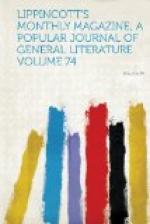The first and principal series of the Sonnets (divided from the second in many editions of Shakespeare by a mark of separation) is clearly addressed to a male friend. The extremely lover-like use of language by which they are characterized was a common trait of the age; and here again we see the necessity of thoroughly understanding the atmosphere that Shakespeare breathed. To us, with our frigid vocabulary of friendship, such a style sounds unnatural, and undignified perhaps: with the Elizabethans it was an every-day habit. Lilly, the author of Euphues, says in his Endymion, “The love of men to women is a thing common and of course; the friendship of man to man, infinite and immortal.” And indeed it is to the influence of the Euphues that much of the poetic ardor of language characterizing the masculine friendship of the time was due. A man’s beauty was as often the theme of verse as a woman’s, and the endearing terms only associated by us with the conversation of lovers were used continually among men. The friends in Shakespeare’s plays, as in all the other dramas and novels of the period, continually address each other as “sweet,” and even “sweet love” and “beloved.” Ben Jonson called himself the “lover” of Camden, and dedicated his eulogistic lines to “my beloved Mr. William Shakespeare.” There is therefore no reason for considering the language of the first series of Sonnets as necessarily inapplicable to a masculine friend. The second series, beginning with the 127th Sonnet, is as evidently addressed, as Mr. Brown says, “to his mistress, on her infidelity;” and the Sonnets end with two upon “Cupid’s Brand,” admitted by all to be separate poems, and wrongfully tacked on to the Sonnets proper.
Taking it for granted, then, from this very literal survey of the text, that the Sonnets are autobiographical, we find their study divided into two branches: (1) the story that the poems themselves tell by the most simple and direct statements; and (2) the conjectural explanation of the personages of that story, involving a careful historical comparison of names and dates, but amounting, after all is said that can be said, simply to conjecture, incapable of direct proof. The first part is to the real lover of Shakespeare and of poetry the only important one; the second concerns that which is mortal and has passed away. The first implies a knowledge of the friendship and the love of Shakespeare; the second the discovery of the names of his friend, of the poet who was his rival in the praises of that friend, and of the mistress who was unworthy of them both; not to mention such other items concerning time and place as might be ascertained by a persevering antiquarian.
It is impossible, within less than a volume, to quote from the Sonnets very freely, therefore we shall be compelled to trust to the reader’s recollection of them, assisted by an occasional reference; this explanation of them being simply a record of the impressions they have produced upon an unbiased mind reading them as one would read any other poetry of the same character.




